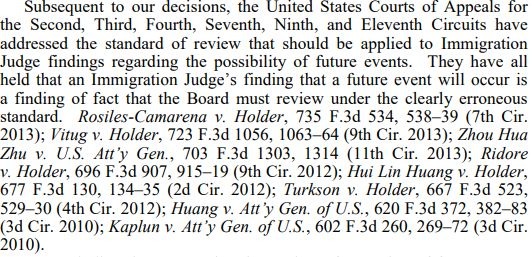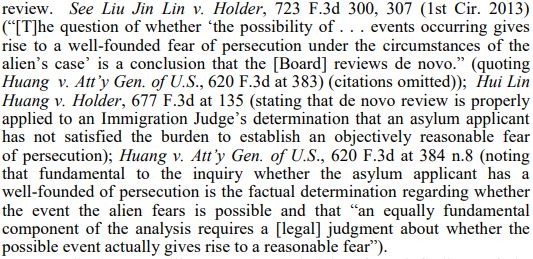- Introduction: Matter of Z-Z-O-, 26 I&N Dec. 586 (BIA 2015)
- Factual and Procedural History: 26 I&N Dec. at 586-
- Analysis and Conclusions Overview: 27 I&N Dec. at 587-88
- Past Persecution Claim: 27 I&N Dec. at 588-
- Proper Standard of Review for Predictive Findings of Fact: 27 I&N Dec. at 589-91
- Applying Rule to Instant Case: 26 I&N Dec. at 591-92
- Conclusion
Introduction: Matter of Z-Z-O-, 26 I&N Dec. 586 (BIA 2015)
On May 26, 2015, the Board of Immigration Appeals (BIA) published an important precedent decision in Matter of Z-Z-O-, 26 I&N Dec. 586 (BIA 2015) [PDF version]. The Board’s two main holdings in Matter of Z-Z-O- dealt with reviewing an immigration judge’s predictive findings of what may or may not occur in the future. This issue is particularly pertinent in cases where the immigration judge is ruling on an application for asylum, withholding of removal, or protection under the Convention Against Torture. First, the Board held that such predictive findings by an immigration judge are “findings of fact,” and thus that they are “subject to a clearly erroneous standard of review.” This means that an immigration judge’s predictive finding cannot be overruled unless it was based on clear error. With this holding, the Board overruled its prior precedents in Matter of V-K-, 24 I&N Dec. 500 (BIA 2008), and Matter of A-S-B-, 24 I&N Dec. 493 (BIA 2008). Secondly, the Board held that, when reviewing whether an applicant for asylum has an objectively reasonable fear of persecution based on events that may occur in the future, it must do so de novo (from the beginning), making its own findings of fact.
In this article, we will examine the factual and procedural history of Matter of Z-Z-O-, the Board’s analysis and conclusions, and what this important decision means for administrative review of certain claims for asylum or protection from removal.
Factual and Procedural History: 26 I&N Dec. at 586-
The respondent, a native and citizen of China, was admitted to the United States as a B2 visitor for pleasure on February 24, 2007. He was authorized to stay in the United States until August 23, 2007. However, he remained longer, and on October 10, 2007, he applied for asylum with the United States Citizenship and Immigration Services (USCIS). The USCIS referred the case for removal proceedings due to the respondent’s overstay. In removal proceedings, the respondent conceded that he was removable for remaining in the United States longer than permitted, and he sought asylum.
In support of his asylum application, the respondent presented the following points:
The respondent and his wife had one son, who was born in China on August 1, 1989.
In 2006, the respondent and his wife discovered that she was approximately one month pregnant.
The respondent’s wife was tested at a hospital and told that she would likely miscarry. She did miscarry shortly thereafter.
On December 18, 2006, the family planning director, a government official, accompanied the respondent’s wife to the hospital to have an intrauterine device implanted.
The respondent and his wife were criticized during a company meeting after she had the intrauterine device implanted, and their wages were reduced.
At the end of December 2006, the respondent and his wife received a notice from family planning authorities stating that one of them was required to undergo sterilization. The respondent left China for the United States after receiving this notice.
The Immigration Judge determined that the respondent failed to meet his burden for establishing eligibility for asylum based on the claim of past persecution consisting of harm and threatened harm from China’s one-child policy,. Accordingly, the Immigration Judge denied the respondent’s application for asylum and ordered him removed from the United States. The respondent appealed from the denial to the BIA. On appeal, the respondent argued that he had established past persecution based on harm and threatened harm from China’s one-child policy, and that he was entitled to a presumption of future persecution on that account. Furthermore, he argued that he had a well-founded fear of persecution based on the threat of forced sterilization.
Analysis and Conclusions Overview: 27 I&N Dec. at 587-88
For the forthcoming reasons, the Board would ultimately dismiss the respondent’s appeal. In the following sections, we will examine the Board’s standard and method of review and how it applied that standard and method to the facts of the instant case.
Past Persecution Claim: 27 I&N Dec. at 588-
The Board first examined the respondent’s claim that he had been subjected to past persecution. It is worth noting that the Board’s two main holdings in the decision — which we discussed in the introduction to this article — did not arise from this section.
The Board agreed with the Immigration Judge that the respondent failed to establish that he had experienced persecution on a protected ground set forth in section 101(a)(42) of the Immigration and Nationality Act (INA). It noted that he was never physically harmed in China and that his wife’s miscarriage did not constitute persecution of the respondent on a protected ground.
First, the Board noted that the Immigration Judge “found no indication that officials intended for the respondent’s wife to have a miscarriage, such that their conduct would constitute a forced abortion.” Furthermore, the Board found no indication that the respondent’s wife’s miscarriage was punishment or the result of punishment from the Chinese government for any actual or perceived resistance to China’s one-child policy by the respondent or his wife. It noted that in Matter of J-S-, 24 I&N Dec. 520, 535 (A.G. 2008) [PDF version], the Attorney General held that a spouse who has not been subjected to forced sterilization must demonstrate “other resistance” to a coercive population control program.
The Immigration Judge determined that the respondent did not face economic sanctions rising to the level of persecution. The Board stated that the respondent did not specifically dispute this determination. To learn more about this issue, please see our general article on asylum claims based on economic persecution [see article].
Finally, the Immigration Judge found that the notice informing the respondent and his wife that one of them would have to be sterilized did not rise to the level of persecution. The Board agreed, noting that “[t]here is no indication that the respondent was pursued or harmed after the notice was issued.” The Board cited to the decision of the United States Court of Appeals for the Ninth Circuit — in which jurisdiction the instant case arose — in Hoxha v. Ashcroft, 319 F.3d 1179, 1182 (9th Cir. 2003) [PDF version]. In Hoxha, the Ninth Circuit held that unfulfilled threats generally “constitute harassment rather than persecution.” In Lim v. INS, 224 F.3d 929, 936 (9th Cir. 2000) [PDF version], the Ninth Circuit held that unfulfilled threats only “constitute past persecution in … a small category of cases, and only when the threats are so menacing as to cause significant actual ‘suffering or harm.’” (Internal citation omitted.)
For the foregoing reasons, the Board held that “[t]he Immigration Judge correctly concluded that the respondent’s experiences in China, when considered either individually or cumulatively, did not constitute past persecution.” Because the respondent did not sustain his burden for establishing past persecution, the presumption of future persecution, under 8 C.F.R. 1208.13(a)-(b); 8 C.F.R. 1240.8(d) ,was not triggered. Thus, the Board moved next to the respondent’s argument that he had established well-founded fear of future persecution.
Proper Standard of Review for Predictive Findings of Fact: 27 I&N Dec. at 589-91
In denying the respondent’s claim that he had a well-founded fear of future persecution in China, the Immigration Judge necessarily had to make predictive findings of fact regarding such a possibility of future events occurring. Before assessing the specific claim, the Board sought to articulate the proper standard of administrative review for an Immigration Judge’s predictive findings of fact.
The Board had previously published two decisions on this very issue. In Matter of A-S-B-, 24 I&N Dec. 493, 498 (BIA 2008) [PDF version], it held that “speculative findings about what may or may not occur to the respondent in the future … is not fact finding, because … it is impossible to declare as ‘fact’ things that have not yet occurred.” In Matter of V-K-, 24 I&N Dec. 500, 501 (BIA 2008) [PDF version], the Board declined to review an Immigration Judge’s finding regarding the possibility of future torture for “clear error,” which is the standard of review for an Immigration Judge’s factual findings, because it did “not consider the prediction of the probability of future torture to be a ruling of ‘fact.’”
However, the Board’s conclusion in Matter of A-S-B- and Matter of V-K- that Immigration Judge findings regarding the probability of future events were not findings of fact had not been well-received by federal appellate courts. In fact, the United States Courts of Appeals for the Second, Third, Fourth, Seventh, Ninth, and Eleventh Circuits had each published precedent decisions disagreeing with the Board. The Board recognized that these circuit courts “have noted that a determination of what will occur in the future has historically and regularly been regarded as a factual finding, even outside the context of immigration law…” You may see the passage of the BIA decision detailing these decisions below:

In the instant case, the Board abandoned its previous position and joined the reasoning and conclusions of the foregoing circuits by “hold[ing] that an Immigration Judge’s predictive findings of what may or may not occur in the future are findings of fact, which are subject to a clearly erroneous standard of review.” The Board overruled Matter of A-S-B- and Matter of V-K- to the extent that they held otherwise. The Board also addressed Matter of H-L-H- & Z-Y-Z-, 25 I&N Dec. 209 (BIA 2010) [PDF version], abrogated by Hui Lin Huang v. Holder, 677 F.3d 130 (9th Cir. 2012) [PDF version], which hd relied extensively on Matter of A-S-B- and Matter of V-K- for the standard of review for predictive factual findings. The Board explained that it would not follow Matter of H-L-H- & X-Y-Z- on that one particular point, but that it would continue to follow the other findings and conclusions reached in the case.
The Board then explained that “whether an asylum applicant has established an objectively reasonable fear of persecution based on the events that the Immigration Judge found may occur upon the applicant’s return to the country of removal is a legal determination that remains subject to de novo review.” This means that the Board must review the factual issues from the beginning and is not bound by the findings a of the immigration judge if it concludes the findings of the immigration judge are clearly erroneous. Below is the Board’s list of several circuit court decisions which have held the same:

The Board the explained the export of its two holdings. First, it stated that “we will accept the underlying factual findings of the Immigration Judge unless they are clearly erroneous, and we will review de novo whether the underlying facts found by the Immigration Judge meet the legal requirements for relief from removal or resolve any other legal issues that are raised.” (Emphasis added.)
Applying Rule to Instant Case: 26 I&N Dec. at 591-92
The Board then applied its new standard of review to the particular facts involved in the instant case. The Board would, for the following reasons, agree with the Immigration Judge’s conclusion.
First, the Board noted that the Immigration Judge found that, after receiving the purported sterilization notice from Chinese family planning authorities, the respondent “faced no reported harm when he returned to China following a trip abroad.” Additionally, there was no evidence that the respondent’s wife had been subjected to forced sterilization after receiving the notice.
Regarding the latter point, the respondent argued that his wife had not been subjected to forced sterilization because she could not have a child without him being in China. However, the Board agreed with the Immigration Judge’s dismissal of this as “speculative,” and it cited to its published decision in Matter of D-R-, 25 I&N Dec. 445, 454-55 (BIA 2011) [PDF version] [see article], wherein it held that Immigration Judges may make reasonable inferences from direct and circumstantial evidence in the record and are not required to accept a respondent’s account where there are other plausible views of the evidence. The Immigration Judge found that, while family planning officials had subsequently visited the respondent’s wife and asked her to undergo sterilization, there was no indication that they attempted to have her sterilized by force. Thus, the Board concluded that “the Immigration Judge reasonably found the respondent’s claim that he is a target for sterilization by family planning authorities to be unpersuasive.”
The Board determined that the Immigration Judge’s factual findings regarding what may have occurred in China and what may occur if the respondent were to be removed to China were supported by the record. Therefore, the Board concluded that they were not clearly erroneous. In Anderson v. City of Bessemer City, N.C., 470 U.S. 564, 574 (1985) [PDF version] [see article], the Supreme Court of the United States held: “Where there are two permissible views of the evidence, the factfinder’s choice between them cannot be clearly erroneous.”
The Board explained that the respondent had not presented evidence that Chinese authorities sought to have him sterilized since the notice was issued in 2006. He submitted no evidence that Chinese authorities sought to persecute him for any other reason. Thus, “[b]ased on the Immigration Judge’s factual findings and the existing evidence of record, we conclude that he properly determined that the respondent did not satisfy his burden of showing that his fear of being sterilized by force, or of suffering other persecutory harm upon his return to China, was objectively reasonable.” For this reason, the Board dismissed the respondent’s appeal.
Conclusion
Matter of Z-Z-O- is an important decision in that the Board adopted the “clear error” standard of review of predictive findings of fact made by an immigration judge. This decision is important in cases where an immigration judge is required to determine the likelihood of future events. In general, the decision narrows the circumstances in which the Board may vacate the decision of an immigration judge based on predictive findings of fact. Mere disagreement with the immigration judge will not suffice. Instead, the immigration judge’s predictive finding of fact must be based on some clear factual error. In the instant case, this favored the government, but it is conceivable in other cases that the rule may favor the alien.
For an interesting look at how the decision has been applied since, please see our article on Matter of J-R-G-P-, 27 I&N Dec. 482 (BIA 2018) [see article]. In the underlying litigation, the immigration judge initially declined an application for protection under the Convention Against Torture on the basis that she concluded that the applicant’s mental health issues were unlikely to come to the attention of authorities in Mexico. The Board vacated and remanded in part because it concluded that this finding of fact by the immigration judge was clearly erroneous. However, the Board ultimately affirmed the immigration judge’s second denial of the application on other grounds under the clear error standard of review.
To learn more about some of the issues discussed in this article, please see our website’s growing collection of articles on asylum and refugee protection [see category] and removal and deportation defense [see category]. To learn about other important immigration precedent decisions, please see our updated article index [see index].





